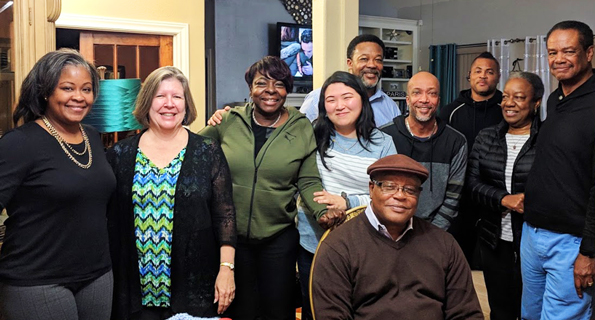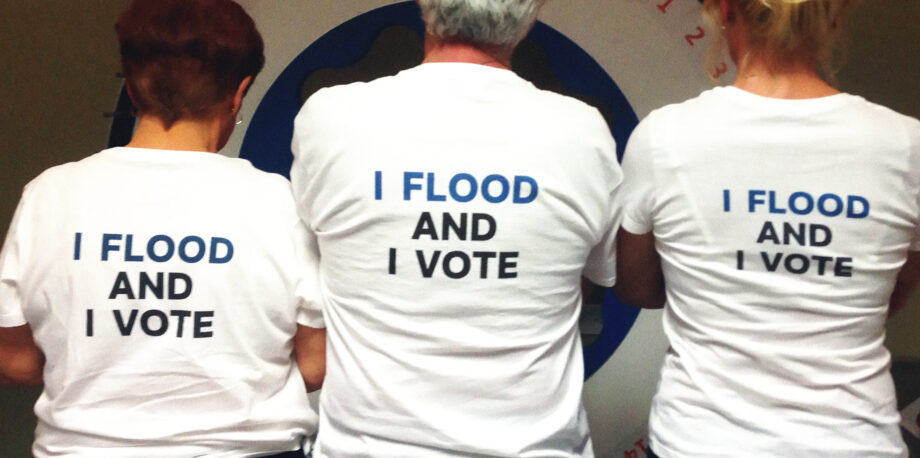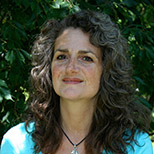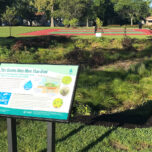April 23, 2019 — Susan Liley didn’t set out to become an activist. “A grandma, that’s all I am,” she says. But when her hometown of De Soto, Missouri, flooded four times in three years, Liley felt called to act.
After the first couple of floods, Liley did what she could do to help her neighbors: She dragged waterlogged furniture from a friend’s home and delivered eggs from her chickens to those without electricity. But the third time around, Liley says, “I got mad.”
Across the U.S., flood survivors are growing in number and — like Liley — they’re getting mad and fighting back. From city streets to subdivisions and trailer parks, they are comparing notes with neighbors and asking hard questions about the rising tide. They are messaging each other on Facebook, packing meeting halls and lawyering up. And, increasingly, they are seeking not just restitution, but answers. Flood survivors are identifying the root causes of repeated flooding and working toward solutions.
Most recently, their ranks were swelled by a March “bomb cyclone” in the Upper Midwest, which unleashed catastrophic flooding that was visible from space. According to the 2018 National Climate Assessment, climate change is driving more severe floods in many parts of the country.
Sea-level rise is inundating coastal cities, where “sunny-day flooding” is now a thing. Rising seas contribute to high-tide flooding, which has grown by a factor of five to 10 since the 1960s in many U.S. coastal communities — and that trend that is expected to accelerate in the future. Farther inland, increased rainfall is a major culprit. Because a warmer atmosphere holds more water vapor, the past few decades have seen many more “heavy precipitation events,” especially in the Northeast, Midwest and upper Great Plains. In the Northeast, for example, heavy rains pack 50 percent more water than they did before 1991. Not surprisingly, those deluges have led to more flooding from Albany, New York, to Duluth, Minnesota.
Not Just the Climate
But climate isn’t the only reason we are seeing more floods. Ill-conceived development, especially in flood-prone areas, replaces water-absorbing forests and wetlands with impermeable surfaces — so there is simply nowhere for all that water to go. While the risks of building in a floodplain may seem obvious, such construction continues nonetheless — in part because waterfront properties are in high demand, commanding premium prices that boost real estate tax income for local governments.

When her hometown of De Soto, Missouri, flooded multiple times in consecutive years, Susan Liley helped form the Citizen’s Committee for Flood Relief to find solutions to the problem. Photo courtesy of Citizen’s Committee for Flood Relief.
In De Soto, both factors are at play. There is more precipitation, according to Liley: “It used to be 3 or 4 inches of rain, and now we get 7 to 10.” But the town also hugs the banks of flood-prone Joachim Creek. Over the years, construction of new homes and roads has thwarted the creek’s natural drainage and put more people in harm’s way.
Liley remembers tragedy striking in 2003, when a flash flood in Joachim Creek led to one death. “We didn’t realize it was a preview of things to come,” Liley says. In 2013, another flash flood killed two people: an elderly woman who was washed away by the torrent, and another who died while being evacuated. When De Soto flooded again in 2015, Liley reached her limit. “Three of us ladies were talking on Facebook and said we have to do something. So we met the next morning, and organized the Citizen’s Committee for Flood Relief.”
The committee’s first priority was to figure out some kind of early warning system. While coastal and riverine floods can be (imperfectly) predicted in advance, flash floods by definition arrive unannounced. Second, they sought to understand the root causes of repeated flooding and address them.
Higher Ground
Liley’s group got a powerful assist from an organization called Higher Ground (formerly Flood Forum USA). A project of the nonprofit Anthropocene Alliance, Higher Ground is the largest national flood survivor network in the U.S. It currently links 43 flood survivor groups in 20 U.S. states — inland and coastal, urban and rural, representing a wide range of demographics and political affiliations. Higher Ground was founded by Harriet Festing, a former British civil servant and goat farmer who came to the U.S. in 2011 when a Conservative government eliminated the climate and energy department for which she worked. Festing took a job with the Center for Neighborhood Technology in Chicago. There she met a woman named Helen Lekavich, a hairstylist-turned-organizer who demonstrated what a passionate group of flood survivors could accomplish.
After enduring repeated floods in her town of Midlothian, Lekavich and her neighbors organized a group called Floodlothian Midlothian, which eventually won a US$7.6 million flood control project from the Metropolitan Water Reclamation District.With 41 million people estimated to be living in flood zones, Festing says, “imagine if we could find Helen Lekaviches across the country and create a unified voice! So that’s what we set out to do.” She reached out to survivors’ groups — finding them on Facebook, in local media and through word of mouth — and Higher Ground was born.
“The leadership to address flooding and other climate impacts needs to come directly from the people and communities that are most affected,” says Festing. But these issues are complex, requiring expertise beyond the understanding (and pocketbooks) of survivor groups. So, in partnership with the American Geophysical Union’s Thriving Earth Exchange and three other partners, Higher Ground matches flood survivors with experts in hydrology, floodplain management, citizen weather monitoring, insurance, law, case management, planning, and architecture.
And Higher Ground links survivors’ groups with one another, so they can trade notes and strategies — for example, by holding a monthly videoconference and leadership forum.
In De Soto, Higher Ground matched Liley’s group with scientists from Saint Louis University and the U.S. Geological Survey who helped create a simple but effective flood warning system. Sensors in Joachim Creek now send messages to a phone app that pings residents when the creek rises over a certain level. “When it’s 8 feet over, we’re in trouble,” says Liley. “But when it’s 10 feet over, you better be out of there because it’s going to be in homes.”
Higher Ground helped Liley’s group petition their senators and members of Congress to commission a US$200,000 watershed study for the city of De Soto. Conducted by the U.S. Army Corps of Engineers and its state-level Silver Jackets team, Liley says the study will show how green infrastructure, such as restored wetlands and parks, can minimize flood risk along Joachim Creek. The study’s completion was delayed by the recent federal government shutdown. And other hurdles remain — namely money. “All this work that the Corps of Engineers has done, without funding for implementation, we will get nowhere,” Liley says. Still, identifying the problem is a crucial first step.
A Flooding Whodunit
Sometimes, identifying the problem has all the drama of a whodunit. That’s how it played out in Richwood, Texas, where residents rode out Hurricane Harvey without any notable flooding.
Then, “four days after Harvey vamoosed on out of here, water started backing up into our neighborhood,” remembers Kevin McKinney, a self-employed transportation safety consultant.
McKinney had 3 feet of water in his home for nine days. “I lost everything I had,” he says. Yet, despite Harvey’s historic rainfall totals, something did not sit right for McKinney and his neighbors. “There are people who have lived here for 45 to 50 years, and never, ever flooded,” McKinney says. “Why now?”
Richwood residents did some investigating; one even deployed a camera-equipped drone to get a bird’s eye view. They claim to have discovered that the City of Lake Jackson used pumps and sandbags to divert floodwater to Richwood’s Bastrop Reservoir, which overflowed into Richwood residents’ homes. “They had three pumps going at 6,800 gallons a minute, running for 10 days,” says McKinney. “The water was actually flowing uphill.” The City of Lake Jackson denies the charges.
The people of Richwood organized. They formed a Facebook group called Flood Victims of Richwood and called meetings that packed a local church. And they joined up with Higher Ground, which matched them to a hydrologist who is using lidar data to analyze the post-Harvey flood. Now more than 400 homeowners are suing the City of Lake Jackson for US$45 million, according to Matias Adrogue, the lawyer representing the citizens of Richwood who brought the lawsuit.
McKinney says the goal of the lawsuit is to find out what happened and make sure it doesn’t happen again. And he wants to see the survivors compensated for their losses. But there is a deeper principle of fairness he wants to address: “We need to find a solution together,” McKinney says. “You just don’t flood your neighbors.”
The Rich Get Richer
Questions of fairness are increasingly on flood survivors’ minds. Floods are sometimes seen as equal-opportunity disasters that affect rich and poor alike. But a substantial body of research (highlighted in a recent exposé by NPR) shows that federal aid actually leaves wealthy, white communities better off after natural disasters — while the reverse is true for low-income communities of color.
Constance C. Luo, a community organizer for the Texas Organizing Project in Houston, has seen this play out in the recovery from Hurricane Harvey. “Harvey did not discriminate,” she says. “People in richer areas did severely flood, and it was terrible. But whether you got assistance depended on things like the flexibility of your employer or whether you had flood insurance. So many wealthy families found themselves to be prosperous after Harvey, while other families go bankrupt.”

The Texas Organizing Project fought for — and won — a county program that prioritizes investment in low-income neighborhoods for flood recovery and prevention. Constance C. Luo, a community organizer for the group (pictured fourth from the left in the middle row), says that the program emphasizes “equity” over making bond projects equal to everyone. Photo courtesy of Texas Organizing Project
The people who went bankrupt, Luo says, are those who work low-wage jobs and cannot take time off work to navigate the complex bureaucracy of disaster assistance. A disproportionate number come from the low-income African-American and Latino neighborhoods of Northeast Houston, where a lack of investment in infrastructure and poor drainage led to a high number of flooded homes.
Given that disparity, the Texas Organizing Project fought for — and won — a county program that prioritizes investment in low-income neighborhoods for flood recovery and prevention. But that plan has drawn fierce opposition from affluent Houstonians who say bond funds should be evenly dispersed throughout the city. “The question,” says Luo, “is whether the bond projects should be equal to everyone, or equitable — weighted toward neighborhoods that traditionally have had very little attention to their flood infrastructure. We stand on the side of equity.”
To bolster its case for equitable flood recovery, the Texas Organizing Project joined up with Higher Ground in 2018. The group was matched with geologist Edith Newton Wilson, owner of Rock Whisperer LLC in Tulsa, Oklahoma, who is mapping flood risks in Northeast Houston. The maps show high and low ground, bayous, drainage infrastructure and other factors that shape risk and resilience.
For Luo and other community residents, the maps are revelatory. “There’s real power to being able to identify your place on a map, and say ‘Oh! People on the other blocks near me suffer from this, too! Oh! We’re all in the floodplain! That’s why our insurance is so high.’” In this way, the mapping project is educating Northeast Houstonians about flood risk management — and providing vital data for advocacy. “I strongly believe that community, fighting hand in hand with science, is an unbeatable force,” says Luo.
The Future of Flooding
That unbeatable force will have much to contend with in the decades to come, as climate change and development raise flood risks across the U.S. In some places, those risks pose an almost existential challenge; the future of the community hinges on finding better ways to channel, divert and live with water.
Charleston, South Carolina, is one such place. Thanks to sea-level rise, land subsidence and development in low-lying areas, Charleston is on track to experience sunny-day flooding more than half the year — 187 days — by 2045.
“What does that mean?” asks Eileen Dougherty, who runs a commercial fishing business in Charleston. “That’s going to massively change the way that we live. That affects our basic safety services, our firefighters. Can the ambulance get to your house? Can children get to school? So, we have a lot of things to look at here in Charleston.”
“We need to have all the municipalities, the governing agencies, on the same page with building and zoning in a way that incorporates best practices. We need to build in a way that preserves our natural environment, preserves our culture and preserves our ability to have that tourism revenue. And I think we can do all that.” –Eileen DoughertyDougherty — like Liley and McKinney — became an unwitting activist on this issue when her land began to flood. The culprit, she believed, was the new 294-unit apartment building next door, which had altered the soil and the flow of water through the neighborhood. She reached out for help from the local municipalities, to no avail. Dougherty now believes that development in Charleston takes what she calls a “whack-a-mole approach,”where large developments are popping up at an alarming rate without adequate drainage solutions and are flooding surrounding properties.
So Dougherty got involved with a group called Fix Flooding First — another Higher Ground affiliate — because she wants to see a more comprehensive approach. “We need to have all the municipalities, the governing agencies, on the same page with building and zoning in a way that incorporates best practices,” she says. “We need to build in a way that preserves our natural environment, preserves our culture and preserves our ability to have that tourism revenue. And I think we can do all that.”
While each community’s challenges are unique, common themes and challenges call out for action at the state or federal level — and even in the most vulnerable places, there is much that can be done to reduce the toll of flooding. For example, across the nation, developers continue to build in floodplains, finding workarounds to ordinances and federal regulations — and, according to Festing, they sometimes adopt dubious tactics to do so. Higher Ground members are alerting one another to these tactics and reporting them to the appropriate authorities, Festing says. In this way, they hope to spark change at a national scale.
There is no way to sugarcoat the challenges ahead. But as the waters rise, so do awareness and determination. Flood survivors are no longer simply victims; they are an ever-growing constituency for change. They are asking vitally important questions. They are challenging longstanding development practices and demanding a more equitable distribution of risks and rewards. They are grappling with the changing climate and its implications for the places we call home.
And they are joining forces. “The big resonating thing that runs through my mind is unity,” says Dougherty. “If you can create a united voice, a united front, that is very powerful.”
Editor’s note: This article was produced by the Island Press Urban Resilience Project, with support from the Kresge Foundation and the JPB Foundation.
Related Posts
Ensia shares solutions-focused stories free of charge through our online magazine and partner media. That means audiences around the world have ready access to stories that can — and do — help them shape a better future. If you value our work, please show your support today.
Yes, I'll support Ensia!




